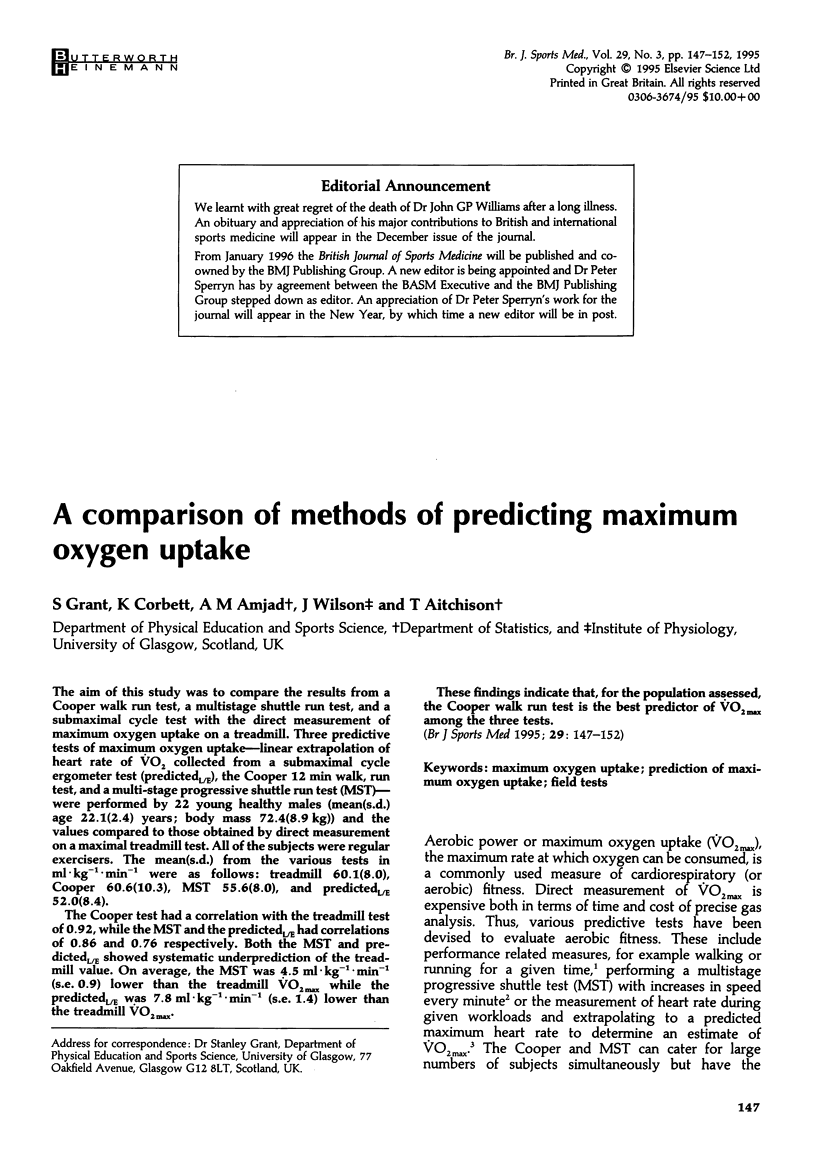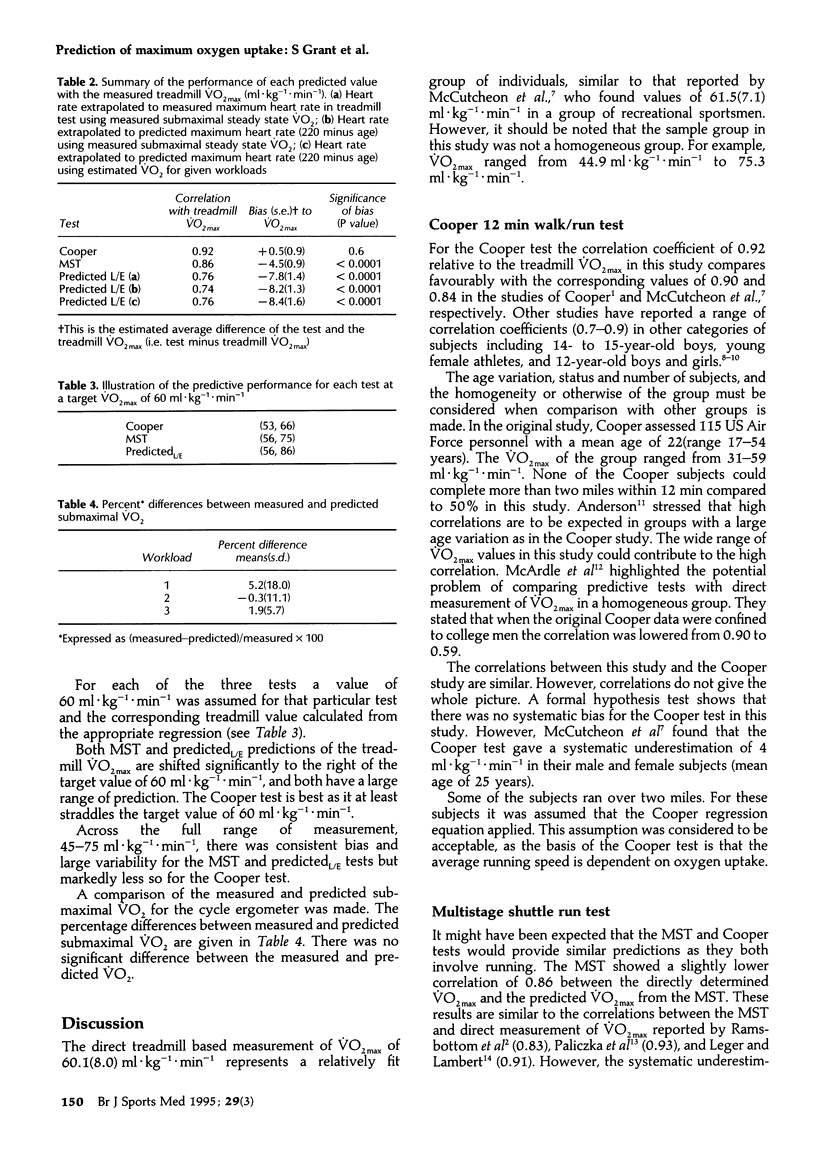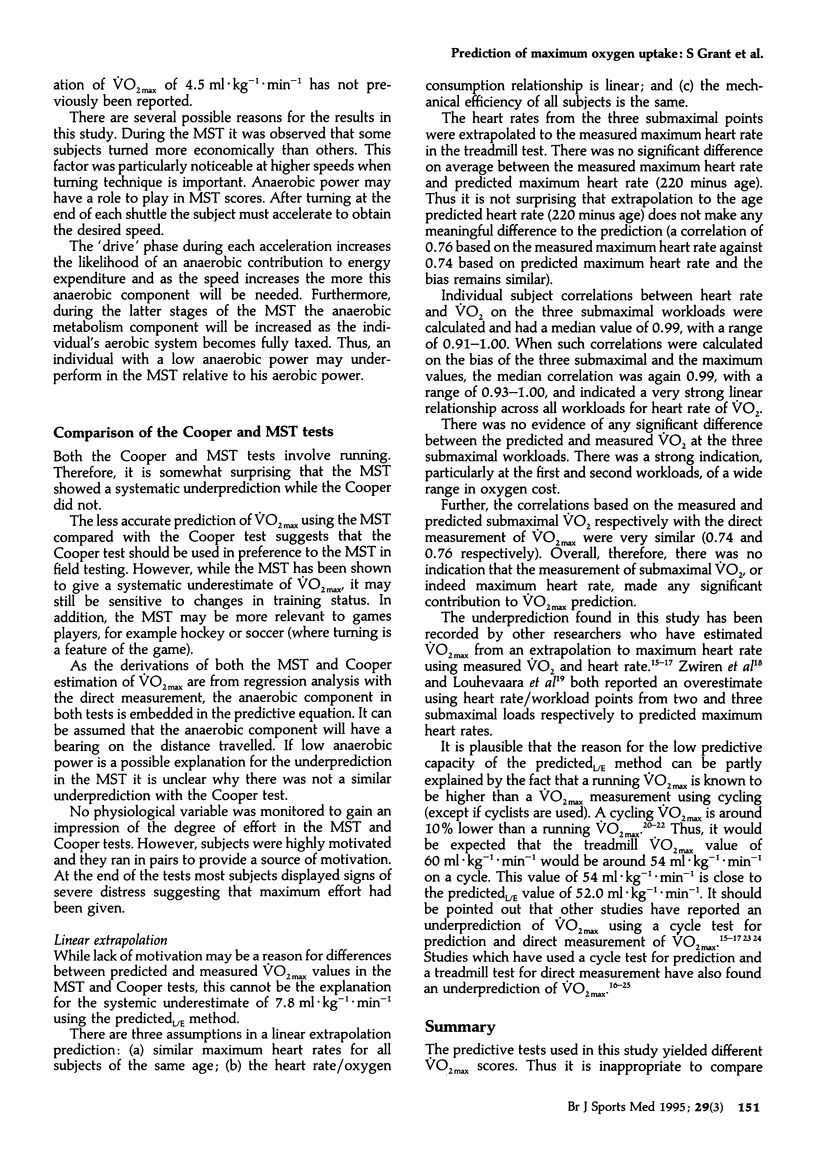Abstract
The aim of this study was to compare the results from a Cooper walk run test, a multistage shuttle run test, and a submaximal cycle test with the direct measurement of maximum oxygen uptake on a treadmill. Three predictive tests of maximum oxygen uptake--linear extrapolation of heart rate of VO2 collected from a submaximal cycle ergometer test (predicted L/E), the Cooper 12 min walk, run test, and a multi-stage progressive shuttle run test (MST)--were performed by 22 young healthy males (mean(s.d.) age 22.1 (2.4) years; body mass 72.4(8.9kg)) and the values compared to those obtained by direct measurement on a maximal treadmill test. All of the subjects were regular exercisers. The mean(s.d.) from the various tests in ml.kg-1.min-1 were as follows: treadmill 60.1(8.0), Cooper 60.6(10.3), MST 55.6(8.0), and predictedL/E 52.0(8.4). The Cooper test had a correlation with the treadmill test of 0.92, while the MST and the predictedL/E had correlations of 0.86 and 0.76 respectively. Both the MST and predictedL/E showed systematic underprediction of the treadmill value. On average, the MST was 4.5 ml.kg-1.min-1 (s.e. 0.9) lower than the treadmill VO2max while the predictedL/E was 7.8 ml.kg-1. min-1 (s.e. 1.4) lower than the treadmill VO2max. These findings indicate that, for the population assessed, the Cooper walk run test is the best predictor of VO2max among the three tests.
Full text
PDF





Selected References
These references are in PubMed. This may not be the complete list of references from this article.
- Anderson G. S. A comparison of predictive tests of aerobic capacity. Can J Sport Sci. 1992 Dec;17(4):304–308. [PubMed] [Google Scholar]
- Cink R. E., Thomas T. R. Validity of the Astrand-Ryhming nomogram for predicting maximal oxygen intake. Br J Sports Med. 1981 Sep;15(3):182–185. doi: 10.1136/bjsm.15.3.182. [DOI] [PMC free article] [PubMed] [Google Scholar]
- Davies C. T. Limitations to the prediction of maximum oxygen intake from cardiac frequency measurements. J Appl Physiol. 1968 May;24(5):700–706. doi: 10.1152/jappl.1968.24.5.700. [DOI] [PubMed] [Google Scholar]
- Doolittle T. L., Bigbee R. The twelve-minute run-walk: a test of cardiorespiratory fitness of adolescent boys. Res Q. 1968 Oct;39(3):491–495. [PubMed] [Google Scholar]
- Faulkner J. A., Roberts D. E., Elk R. L., Conway J. Cardiovascular responses to submaximum and maximum effort cycling and running. J Appl Physiol. 1971 Apr;30(4):457–461. doi: 10.1152/jappl.1971.30.4.457. [DOI] [PubMed] [Google Scholar]
- Fitchett M. A. Predictability of VO2 max from submaximal cycle ergometer and bench stepping tests. Br J Sports Med. 1985 Jun;19(2):85–88. doi: 10.1136/bjsm.19.2.85. [DOI] [PMC free article] [PubMed] [Google Scholar]
- Jackson A. S., Coleman A. E. Validation of distance run tests for elementary school children. Res Q. 1976 Mar;47(1):86–94. [PubMed] [Google Scholar]
- Léger L. A., Lambert J. A maximal multistage 20-m shuttle run test to predict VO2 max. Eur J Appl Physiol Occup Physiol. 1982;49(1):1–12. doi: 10.1007/BF00428958. [DOI] [PubMed] [Google Scholar]
- Maksud M. G., Cannistra C., Dublinski D. Energy expenditure and VO2 max of female athletes during treadmill exercise. Res Q. 1976 Dec;47(4):692–697. [PubMed] [Google Scholar]
- McCutcheon M. C., Sticha S. A., Giese M. D., Nagle F. J. A further analysis of the 12-minute run prediction of maximal aerobic power. Res Q Exerc Sport. 1990 Sep;61(3):280–283. doi: 10.1080/02701367.1990.10608692. [DOI] [PubMed] [Google Scholar]
- Miles D. S., Critz J. B., Knowlton R. G. Cardiovascular, metabolic, and ventilatory responses of women to equivalent cycle ergometer and treadmill exercise. Med Sci Sports Exerc. 1980 Spring;12(1):14–19. [PubMed] [Google Scholar]
- Miyamura M., Honda Y. Oxygen intake and cardiac output during maximal treadmill and bicycle exercise. J Appl Physiol. 1972 Feb;32(2):185–188. [PubMed] [Google Scholar]
- Paliczka V. J., Nichols A. K., Boreham C. A. A multi-stage shuttle run as a predictor of running performance and maximal oxygen uptake in adults. Br J Sports Med. 1987 Dec;21(4):163–165. doi: 10.1136/bjsm.21.4.163. [DOI] [PMC free article] [PubMed] [Google Scholar]
- Ramsbottom R., Brewer J., Williams C. A progressive shuttle run test to estimate maximal oxygen uptake. Br J Sports Med. 1988 Dec;22(4):141–144. doi: 10.1136/bjsm.22.4.141. [DOI] [PMC free article] [PubMed] [Google Scholar]
- Zwiren L. D., Freedson P. S., Ward A., Wilke S., Rippe J. M. Estimation of VO2max: a comparative analysis of five exercise tests. Res Q Exerc Sport. 1991 Mar;62(1):73–78. doi: 10.1080/02701367.1991.10607521. [DOI] [PubMed] [Google Scholar]


